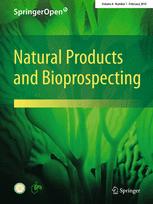|
|
Six New 9,19-Cycloartane Triterpenoids from Cimicifuga foetida L
Collect
Guo-Lei Zhu, Di-Fan Zhu, Luo-Sheng Wan, Xing-Rong Peng, Ni-Man Bao, Zhi-Run Zhang, Lin Zhou, Ming-Hua Qiu
Natural Products and Bioprospecting. 2016, 6 (4): 187-193.
DOI: 10.1007/s13659-016-0097-3
Six new 9,19-cycloartane triterpene derivatives, as well as 3 known analogues (7-9), were isolated from the roots of Cimicifuga foetida L. Their structures were established on the basis of extensive spectroscopic analyses (IR, UV, ORD, HRESIMS, 1D and 2D NMR).
References |
Related Articles |
Metrics
|
|
|
Phytochemical Analysis and Antifungal Activity of Extracts from Leaves and Fruit Residues of Brazilian Savanna Plants Aiming Its Use as Safe Fungicides
Collect
Caroline Alves Breda, Alessandra Marcon Gasperini, Vera Lucia Garcia, Karin Maia Monteiro, Giovana Anceski Bataglion, Marcos Nogueira Eberlin, Marta Cristina Teixeira Duarte
Natural Products and Bioprospecting. 2016, 6 (4): 195-204.
DOI: 10.1007/s13659-016-0101-y
The increasing demand for safe food without preservatives or pesticides residues has encouraged several studies on natural products with antifungal activity and low toxicity. In this study, ethanolic extracts from leaves and fruit residues (peel and seeds) of three Brazilian savanna species (Acrocomia aculeata, Campomanesia adamantium and Caryocar brasiliense) were evaluated against phytopathogenic fungi. Additionally, the most active extract was chemically characterized by ESI-MS and its oral acute toxicity was evaluated. Extracts from C. brasiliense (pequi) peel and leaves were active against Alternaria alternata, Alternaria solani and Venturia pirina with minimal inhibitory concentrations between 350 and 1000 μg/mL. When incorporated in solid media, these extracts extended the lag phase of A. alternata and A. solani and reduced the growth rate of A. solani. Pequi peel extract showed better antifungal activity and their ESI-MS analysis revealed the presence of substances widely reported as antifungal such as gallic acid, quinic acid, ellagic acid, glucogalin and corilagin. The oral acute toxicity was relatively low, being considered safe for use as a potential natural fungicide.
References |
Related Articles |
Metrics
|
|
|
Two New Highly Oxygenated Spirostanol Saponins from Paris polyphylla var. stenophylla
Collect
Ling-Yu Jin, Ting-Xiang Lu,. Xu-Jie Qin, Wei Ni, Huan Yan, Yu Chen, Hui Liu, Hong-Ping He, Hai-Yang Liu
Natural Products and Bioprospecting. 2016, 6 (4): 205-210.
DOI: 10.1007/s13659-016-0102-x
Phytochemical investigation of the rhizomes of Paris polyphylla var. stenophylla led to the isolation of two new highly oxygenated spirostanol saponins, named paristenosides A (1) and B (2), together with seven known compounds. Their structures were established mainly on the base of NMR spectroscopic techniques and mass spectrometry, as well as chemical methods. In addition, the cytotoxicity of the two new saponins was tested.
References |
Related Articles |
Metrics
|
|
|
Sesquiterpenoids from the Rhizomes of Homalomena occulta
Collect
Jun-Li Yang, Ya-Min Zhao, Yan-Ping Shi
Natural Products and Bioprospecting. 2016, 6 (4): 211-216.
DOI: 10.1007/s13659-016-0104-8
Naturally occurring oplopanane sesquiterpenoids are rarely reported. A phytochemical investigation on the rhizomes of Homalomena occulta (Lours) has resulted in the discovery of six oplopanane sesquiterpenoids (1-6), including four new (1-4) and one 3,5-seco-oplopanane (6), together with three previously reported sesquiterpenoids (7-9). In addition three new oplopananes (2a-4a) were also obtained by chemical transformation. All structures of these sesquiterpenoids were established based on the comprehensive spectroscopic analyses, including NMR, MS, and IR, and comparing with the literatures.
References |
Related Articles |
Metrics
|
|
|
Characterization of New Ent-kaurane Diterpenoids of Yunnan Arabica Coffee Beans
Collect
Rui Chu, Luo-Sheng Wan, Xing-Rong Peng, Mu-Yuan Yu, Zhi-Run Zhang, Lin Zhou, Zhong-Rong Li, Ming-Hua Qiu
Natural Products and Bioprospecting. 2016, 6 (4): 217-223.
DOI: 10.1007/s13659-016-0099-1
Five new ent-kaurane diterpenoids, named mascaroside III-V (1-3), and 20-nor-cofaryloside I-II (4-5), together with seven known diterpenoids, were isolated from methanol extracts of the green coffee beans of Yunnan Arabica Coffee. Their chemical structures were elucidated by extensive spectroscopic analyses. Meanwhile, cytotoxicity assay against HL-60, A-549, SMMC-7721, MCF-7 and SW480 cell lines showed that they have not evident inhibition of cytotoxicity.
References |
Related Articles |
Metrics
|
|
|
Spiralosides A-C, Three New C27-Steroidal Glycoalkaloids from the Fruits of Solanum spirale
Collect
Dan Li, Yun-Li Zhao, Xu-Jie Qin, Lu Liu, Xing-Wei Yang, Ying-Ying Chen, Bei Wang, Xin Wei, Ya-Ping Liu, Xiao-Dong Luo
Natural Products and Bioprospecting. 2016, 6 (4): 225-231.
DOI: 10.1007/s13659-016-0103-9
Three new C27-steroidal glycoalkaloids, spiralosides A-C (1-3), were obtained from the total alkaloids of Solanum spirale by chromatographic methods. On the basis of spectroscopic evidence, spiralosides A-C were elucidated as (22R,25S)-22,26-epiminocholest-5-ene-3β,16α-diol-N-acetyl-3-O-α-L-rhamnopyranosyl-(1→4)-β-D-glucopyranosyl (1), (22R,25S)-22,26-epiminocholest-5-ene-3β,16α-diol-N-acetyl-3-O-β-D-glucopyranosyl (2), (22R,25S)-22,26-epiminocholest-3β,16α-diol-N-acetyl-3-O-β-D-glucopyranosyl (3), respectively. The total alkaloids of S. spirale have been screened for their antitussive and expectorant effects in intact animal model.
References |
Related Articles |
Metrics
|
|

